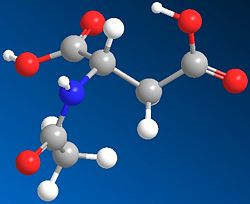N-acetylaspartate
N-acetylaspartate (NAA) is the second most concentrated compound in the human brain, with glutamate being the most concentrated. Despite its high concentration in the brain, the functions performed by NAA remain uncertain and controversial. NAA is synthesized primarily by neurons in the nervous system, but currently there are no theories that account for the extremely high levels that neurons produce.
Is NAA an acetyl group shuttle essential for myelin synthesis?
NAA is synthesized in neuronal mitochondria, but its main metabolizing enzyme, N-acetyl-l-aspartate amidohydrolase (aspartoacylase), is located primarily in the white matter. Based on the precise localization of this enzyme (in lipid-rich myelin sheaths) and on the fact that it produces acetyl groups, it was proposed that NAA is present in such high concentrations in the brain to provide a readily available reserve of acetyls for myelin synthesis.[1]
References
- ↑ Chakraborty, G.; Mekala, P.; Yahya, D.; Wu, G.; Ledeen, R.W. (2001), "Intraneuronal N-acetylaspartate supplies acetyl groups for myelin lipid synthesis: Evidence for myelin-associated aspartoacylase", Journal of Neurochemistry 78 (4): 736–745, DOI:10.1046/j.1471-4159.2001.00456.x
